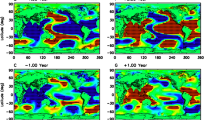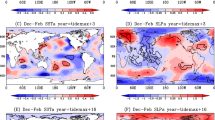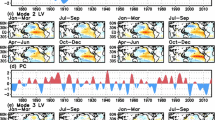Abstract
As the climate is rapidly changing already, it is important to understand how the El Niño-Southern Oscillation (ENSO) has changed in recent decades, and this can shed light on future ENSO characteristics. The ERA5 data were used to analyze the amplitude, duration, variability, and seasonal frequency of El Niño and La Niña, and to investigate whether there have been changes in the amplitude and duration of these events during the period 1959–2021. During this period, variability in the amplitude of El Niño events has been much higher than that of La Niña events. Rainfall anomalies in the Niño 3.4 region also show much higher variability during El Niño compared with La Niña events, while variability in the duration of El Niño events has been much lower than that of La Niña events. The highest frequency of El Niño events is in boreal autumn and winter, while their lowest frequency is in boreal spring and summer. The frequency of La Niña events also varies seasonally, with the highest frequency in boreal autumn, but the lowest frequency in the late boreal spring to mid-summer. Both El Niño and La Niña reach the peak amplitude toward the end of the calendar year, while their minimum amplitudes occur in boreal spring. Significant positive and negative sea surface temperature (SST) trends are identified in the western and eastern tropical South Pacific, respectively, implying the strengthening of the zonal SST gradient in the tropical Pacific during the period 1959–2021. Despite that, the amplitude and duration of El Niño and La Niña events have not changed significantly over the past six decades, implying that these ENSO characteristics have not been largely influenced by a climate change signal.






Similar content being viewed by others
Data availability
The data are available at the ECMWF data server: https://cds.climate.copernicus.eu/cdsapp#!/dataset/reanalysis-era5-single-levels-monthly-means?tab=form.
References
Alexander MA, Blade I, Newman M, Lanzante JR, Lau NC, Scott JD (2002) The atmospheric bridge: The influence of ENSO teleconnections on air-sea interaction over the global oceans. J Clim 15:2205–2231
Alizadeh O, Qadimi M, Zolghadrshojaee M, Irannejad P (2022) Frequency of different types of El Niño events under global warming. Int J Climatol. In press. https://doi.org/10.1002/joc.7858
Alizadeh-Choobari O (2017) Contrasting global teleconnection features of the eastern Pacific and central Pacific El Niño events. Dyn Atmos Oceans 80:139–154
An SI, Jin FF (2004) Nonlinearity and asymmetry of ENSO. J Clim 17:2399–2412
Beobide-Arsuaga G, Bayr T, Reintges A, Latif M (2021) Uncertainty of ENSO-amplitude projections in CMIP5 and CMIP6 models. Clim Dyn 56:3875–3888
Bjerknes J (1969) Atmospheric teleconnections from the equatorial Pacific. Mon Weather Rev 97:163–172
Brown JR, Brierley CM, An SI, Guarino MV, Stevenson S, Williams CJR, Zhang Q, Zhao A, Abe-Ouchi A, Braconnot P, Brady EC, Chandan D, D’Agostino R, Guo C, Legrande AN, Lohmann G, Morozova PA, Ohgaito R, O’ishi R, Otto-Bliesner BL, Peltier WR, Shi X, Sime L, Volodin EM, Zhang Z, Zheng W (2020) Comparison of past and future simulations of ENSO in CMIP5/PMIP3 and CMIP6/PMIP4 models. Clim Past 16:1777–1805
Brown PT, Caldeira K (2017) Greater future global warming inferred from Earth’s recent energy budget. Nature 552:45–50
Cai W, Borlace S, Lengaigne M, van Rensch P, Collins M, Vecchi G, Timmermann A, Santoso A, McPhaden MJ, Wu L, England MH, Wang G, Guilyardi E, Jin FF (2014) Increasing frequency of extreme El Niño events due to greenhouse warming. Nat Clim Change 4:111–116
Cai W, Wu L, Lengaigne M, Li T, McGregor S, Kug JS, Yu JY, Stuecker MF, Santoso A, Li X, Ham YG, Chikamoto Y, Ng B, McPhaden MJ, Du Y, Dommenget D, Jia F, Kajtar JB, Keenlyside N, Lin X, Luo JJ, Martín-Rey M, Ruprich-Robert Y, Wang G, Xie SP, Yang Y, Kang SM, Choi JY, Gan B, Kim GI, Kim CE, Kim S, Kim JH, Chang P (2019) Pantropical climate interactions. Science 363:eaav4236
Cai W, Santoso A, Collins M, Dewitte B, Karamperidou C, Kug JS, Lengaigne M, McPhaden MJ, Stuecker MF, Taschetto AS, Timmermann A, Wu L, Yeh SW, Wang G, Ng B, Jia F, Yang Y, Ying J, Zheng XT, Brown BayrJRTobias, Capotondi A, Cobb KM, Gan B, Geng T, Ham YG, Jin FF, Jo HS, Li X, Lin X, McGregor S, Park JH, Stein K, Yang K, Zhang L, Zhong W (2021) Changing El Niño-Southern Oscillation in a warming climate. Nat Rev Earth Environ 2:628–644
Callahan CW, Chen C, Rugenstein M, Bloch-Johnson J, Yang S, Moyer EJ (2021) Robust decrease in El Niño/Southern Oscillation amplitude under long-term warming. Nat Clim Change 11:752–757
Cane MA (2005) The evolution of El Niño, past and future. Earth Planet Sci Lett 230:227–240
Cane MA, Clement AC, Kaplan A, Kushnir Y, Pozdnyakov D, Seager R, Zebiak SE, Murtugudde R (1997) Twentieth-century sea surface temperature trends. Science 275:957–960
Chemke R, Polvani LM (2019) Opposite tropical circulation trends in climate models and in reanalyses. Nat Geosci 12:528–532
Chen HC, Jin FF (2020) Fundamental behavior of ENSO phase locking. J Clim 33:1953–1968
Chung ES, Timmermann A, Soden BJ, Ha KJ, Shi L, John VO (2019) Reconciling opposing Walker circulation trends in observations and model projections. Nat Clim Change 9:405–412
Clement AC, Seager R, Cane MA, Zebiak SE (1996) An ocean dynamical thermostat. J Clim 9:2190–2196
England MH, McGregor S, Spence P, Meehl GA, Timmermann A, Cai W, Sen Gupta A, McPhaden MJ, Purich A, Santoso A (2014) Recent intensification of wind-driven circulation in the Pacific and the ongoing warming hiatus. Nat Clim Change 4:222–227
Falster G, Konecky B, Madhavan M, Stevenson S, Coats S (2021) Imprint of the Pacific Walker circulation in global precipitation δ18O. J Clim 34:8579–8597
Garreaud RD (2018) A plausible atmospheric trigger for the 2017 coastal El Niño. Int J Climatol 38:e1296-31,302
Ham YG, Kug JS, Park JY, Jin FF (2013) Sea surface temperature in the north tropical Atlantic as a trigger for El Ni no/Southern Oscillation events. Nat Geosci 6:112–116
Hersbach H, Bell B, Berrisford P, Hirahara S, Horányi A, Muñoz Sabater J, Nicolas J, Peubey C, Radu R, Schepers D, Simmons A, Soci C, Abdalla S, Abellan X, Balsamo G, Bechtold P, Biavati G, Bidlot J, Bonavita M, Chiara G, Dahlgren P, Dee D, Diamantakis M, Dragani R, Flemming J, Forbes R, Fuentes M, Geer A, Haimberger L, Healy S, Hogan RJ, Hólm E, Janisková M, Keeley S, Laloyaux P, Lopez P, Lupu C, Radnoti G, Rosnay P, Rozum I, Vamborg F, Villaume S, Thépaut J (2020) The ERA5 global reanalysis. Q J R Meteorol Soc 146:1999–2049
Latif M, Keenlyside NS, Schellnhuber HJ (2009) El Niño/Southern Oscillation response to global warming. Proc Natl Acad Sci USA 106:20,578-20,583
Lee SK, Lopez H, Chung ES, DiNezio P, Yeh SW, Wittenberg AT (2018) On the fragile relationship between El Niño and California rainfall. Geophys Res Lett 45:907–915
Lian T, Chen D, Ying J, Huang P, Tang Y (2018) Tropical Pacific trends under global warming: El Niño-like or La Niña-like? National Sci Rev 5:810–812
Lopez H, Lee SK, Kim D, Wittenberg AT, Yeh SW (2022) Projections of faster onset and slower decay of El Niño in the 21st century. Nat Commun 13:1915
Luo JJ, Wang G, Dommenget D (2018) May common model biases reduce CMIP5’s ability to simulate the recent Pacific La Niña-like cooling? Clim Dyn 50:1335–1351
Marjani S, Alizadeh-Choobari O, Irannejad P (2019) Frequency of extreme El Niño and La Niña events under global warming. Clim Dyn 53:5799–5813
McPhaden MJ, Zebiak SE, Glantz MH (2006) ENSO as an integrating concept in Earth science. Science 314:1740–1745
Misra V, Marx L, Brunke M, Zeng X (2008) The equatorial Pacific cold tongue bias in a coupled climate model. J Clim 21:5852–5869
Neelin JD, Jin HH, Fand Syu F (2000) Variations in ENSO phase locking. J Clim 13:2570–2590
Okumura YM, Deser C (2010) Asymmetry in the duration of El Niño and La Niña. J Clim 23:5826–5843
Olonscheck D, Rugenstein M, Marotzke J (2020) Broad consistency between observed and simulated trends in sea surface temperature patterns. Geophys Res Lett 47:e2019GL08,677
Qadimi M, Alizadeh O, Irannejad P (2021) Impacts of the El Niño-Southern Oscillation on the strength and duration of the Indian summer monsoon. Meteorol Atmos Phys 133:553–564
Rasmusson EM, Carpenter TH (1982) Variations in tropical sea surface temperature and surface wind fields associated with the Southern Oscillation/El Niño. Mon Weather Rev 110:354–384
Richardson MT (2022) Prospects for detecting accelerated global warming. Geophys Res Lett 49:e2021GL095,782
Seager R, Cane M, Henderson N, Lee DE, Abernathey R, Zhang H (2019) Strengthening tropical Pacific zonal sea surface temperature gradient consistent with rising greenhouse gases. Nat Clim Change 9:517–522
Shaman J, Tziperman E (2016) The superposition of eastward and westward Rossby waves in response to localized forcing. J Clim 29:7547–7557
Tang T, Luo JJ, Peng K, Qi L, Tang S (2021) Over-projected Pacific warming and extreme El Niño frequency due to CMIP5 common biases. Natl Sci Rev 8:nwab056
Vecchi GA, Soden BJ (2007) Global warming and the weakening of the tropical circulation. J Clim 20:4316–4340
Vecchi GA, Wittenberg AT (2010) El Niño and our future climate: where do we stand? WIREs Clim Change 1:260–270
Vecchi GA, Soden BJ, Wittenberg AT, Held IM, Leetmaa A, Harrison MJ (2006) Weakening of tropical Pacific atmospheric circulation due to anthropogenic forcing. Nature 441:73–76
Wang B, Luo X, Yang YM, Sun W, Cane MA, Cai W, Yeh SW, Liu J (2019) Historical change of El Niño properties sheds light on future changes of extreme El Niño. Proc Natl Acad Sci USA 116:22,512-22,517
Ward PJ, Jongman B, Kummu MS, Dettinger MD, Sperna Weiland FC, Winsemius HC (2014) Strong influence of El Niño Southern Oscillation on flood risk around the world. Proc Natl Acad Sci USA 111:15,659-15,664
Wittenberg AT (2009) Are historical records sufficient to constrain ENSO simulations? Geophys Res Lett 36:L12,702
Xu K, Wang W, Liu B, Zhu C (2019) Weakening of the El Niño amplitude since the late 1990s and its link to decadal change in the North Pacific climate. Int J Clim 39:4125–4138
Ying J, Collins M, Cai W, Timmermann A, Huang P, Chen D, Stein K (2022) Emergence of climate change in the tropical Pacific. Nat Clim Change 12:356–364
Zhang W, Li J, Zhao X (2010) Sea surface temperature cooling mode in the Pacific cold tongue. J Geophys Res: Oceans 115:C12,042
Zheng XT, Xie SP, Lv LH, Zhou ZQ (2016) Intermodel uncertainty in ENSO amplitude change tied to Pacific Ocean warming pattern. J Clim 29:7265–7279
Zou Y, Xi X (2021) An ongoing cooling in the eastern Pacific linked to eastward migrations of the Southeast Pacific Subtropical Anticyclone. Environ Res Lett 16:34,020
Acknowledgements
The author would like to thank two anonymous reviewers for their detailed and helpful comments.
Funding
This work has been financially supported by Iran National Science Foundation (INSF) under grant number 99029635.
Author information
Authors and Affiliations
Contributions
Omid Alizadeh is the sole author of this article.
Corresponding author
Ethics declarations
Competing interests
The author declares no competing interests.
Additional information
Publisher’s note
Springer Nature remains neutral with regard to jurisdictional claims in published maps and institutional affiliations.
Rights and permissions
Springer Nature or its licensor holds exclusive rights to this article under a publishing agreement with the author(s) or other rightsholder(s); author self-archiving of the accepted manuscript version of this article is solely governed by the terms of such publishing agreement and applicable law.
About this article
Cite this article
Alizadeh, O. Amplitude, duration, variability, and seasonal frequency analysis of the El Niño-Southern Oscillation. Climatic Change 174, 20 (2022). https://doi.org/10.1007/s10584-022-03440-w
Received:
Accepted:
Published:
DOI: https://doi.org/10.1007/s10584-022-03440-w




